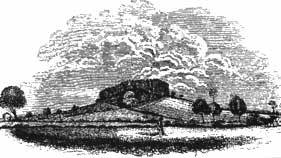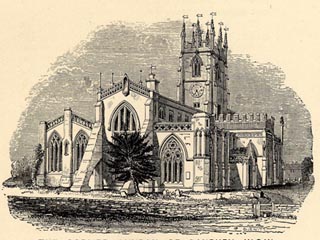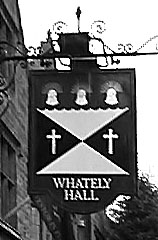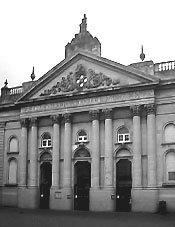The Rollright Stones 
Introduction
This web site is based on a booklet which was designed to make aspects of Banbury’s religious life more accessible to interested parties. Whilst it is important to remember that Banbury is now a modern multi-cultural multi-faith community it is also useful to know something of its past. A directory of contacts for living faith communities within the town reminds us that religious observances continue to play a vital part in the life of Banbury. Of the many factors which have shaped the town’s growth one of the most important yet perhaps most frequently overlooked is that of religion. Religious institutions and individuals have shaped the town we live in today
The Rollright Stones 
Nobody is sure how and when Banbury began but archaeology and the evidence from place names give us a few clues. There is nothing to suggest early settlement in Banbury itself although there are other prehistoric sites in the vicinity. Early religious sites include Neolithic burial chambers at Enstone (SP378236) and Rollright and of course the famous Bronze Age stone circle known as the Rollright Stones (SP296308). Bronze age tombs in the form of earth mounds used to be visible on Tadmarton Heath near to the Iron Age fort .
Iron Age and Roman sites are also known from the area but there are no religious monuments of either period close by. However, Crouch Hill on the outskirts of the town has a Celtic name and its use for May Day celebrations when children would process out of town carrying floral garlands suggest a pre-christian religious association
Crouch Hill in the nineteenth century  .
.
The town probably first began some time late in the sixth century when Saxon settlers first moved up the Cherwell valley. The first settlement lay on a low hill overlooking the crossing point of two locally important routes. The name of the town suggests a defended settlement or ‘burgh’ built under the control of one Banna. It is interesting to note that on the other side of the valley is Grim’s burgh, a name which suggests pagan origins. As both of these early settlements were probably fortified it is intriguing to speculate as to whether Banbury was Christian from the outset thus creating a little local animosity with the pagans over the way!
Whatever the case by the tenth century Banbury had an important minster church which held sway over a large area. As a religious and commercial centre the new town grew rapidly. After the Norman Conquest the town was transferred to the see of Lincoln. In the late twelfth century Bishop Alexander laid out a market place adjacent to his new castle together with long strips of land called burgage plots on which shops and businesses could be started. Once again religion and commerce went hand in hand. As a major landowner the church authorities were also responsible for laying out the suburb of “Newlands” in the fifteenth century.
Of course religious disagreements were one of the root causes of the English Civil War, a conflict which did untold damage to the town in the seventeenth century. Banbury was noted for its puritan ways, a philosophy which lead to the removal of the town’s medieval crosses and ultimately to the demolition of the town’s fine medieval church, known as the cathedral of North Oxfordshire
.
St.Mary's Church prior to its demolition in 1790 
By the mid-eighteenth century the town was starting to recover and development continued through the nineteenth century with various local philanthropists, particularly from the non-conformist tradition, contributing to the town’s growth and building the range of monuments, chapels and schools which are now the most obvious survivals of the town’s religious past.
.
Town Trail
This is simply a suggested route, it does not include every single site in the town centre, there are still discoveries
to be made. There are also of course other sites away from the town centre which have been listed separately.
Thanks to Bryan Martin RIBA for his support and advice on this project.
THE PAGES THAT FOLLOW ARE BEST VIEWED ACROSS THE FULL WIDTH OF THE SCREEN
 |
|||||||||||||||||||||
|
|||||||||||||||||||||
Signs and Symbols Around the Town
 .........................................
.........................................
Not surprisingly given its Christian past most of the symbolism seen on the town’s older buildings is Christian such as the crosses on the coat of arms outside the Whately Hall Hotel. However, there are a number of surprising additions to the townscape. Take for example the figure moulded onto the front of the premises of S. & H. Jones the wine merchants. Is this Vishnu or the Lord Buddha, and what exactly is it doing there?
 The Corn Exchange .......The Town Hall.
The Corn Exchange .......The Town Hall. 
Then there is the restored figure of the Roman goddess of the harvest, Ceres who adorns the main entrance to the Castle Shopping Centre, once the town’s Central Corn Exchange. Seen to good effect on the town hall and spread widely around the town is the ‘sun in splendour’ an icon associated with the town corporation and derived ultimately from the Roman ‘Sun Triumphant’. As other cultural groups make their presence felt in the town other examples of non-Christian symbols are likely to become more visible

© Stephen Wass MMI